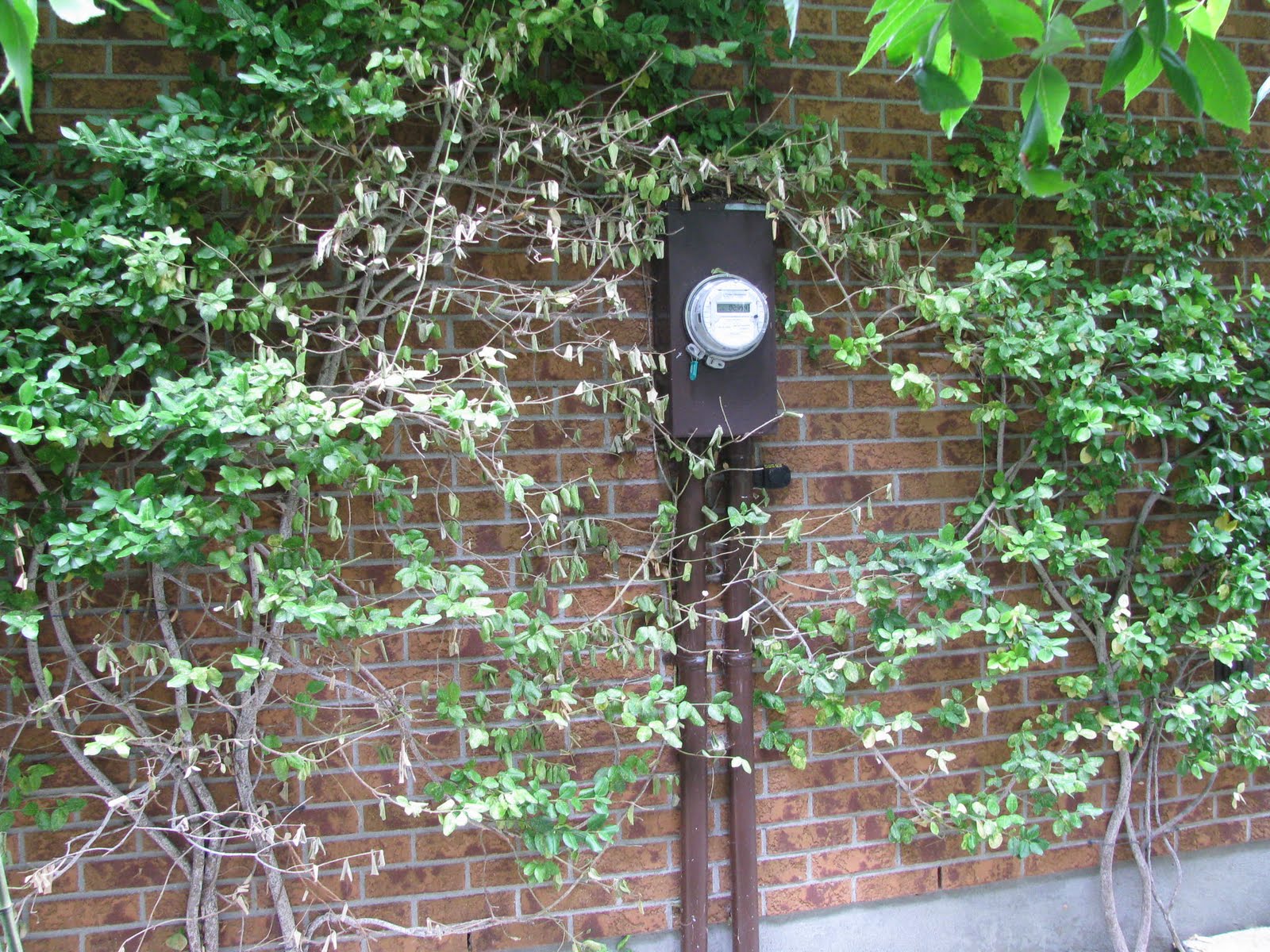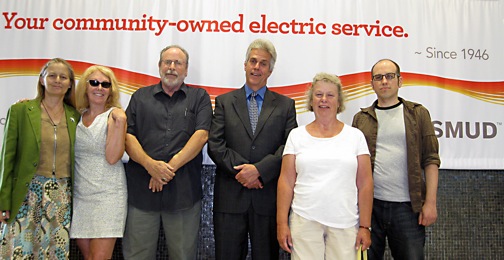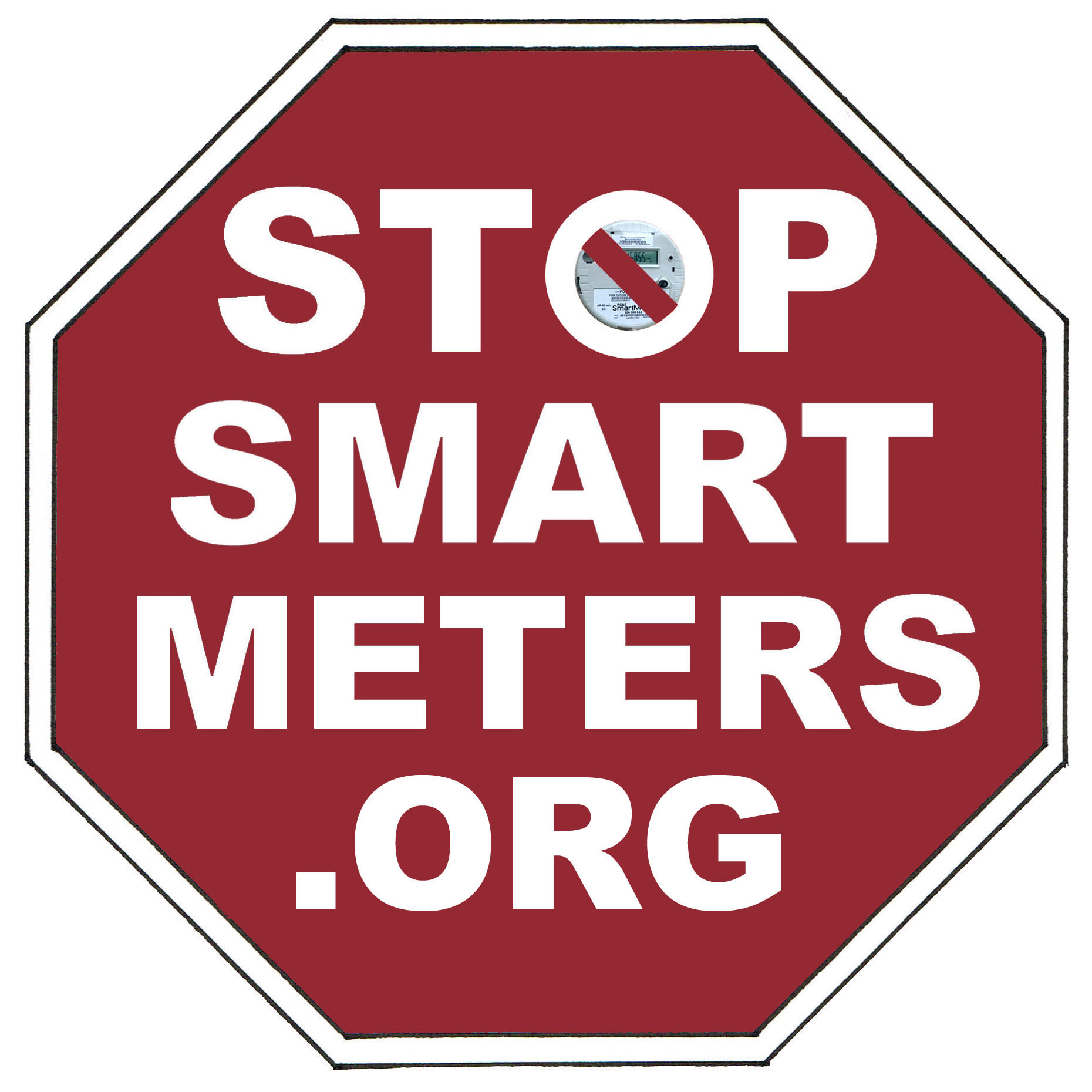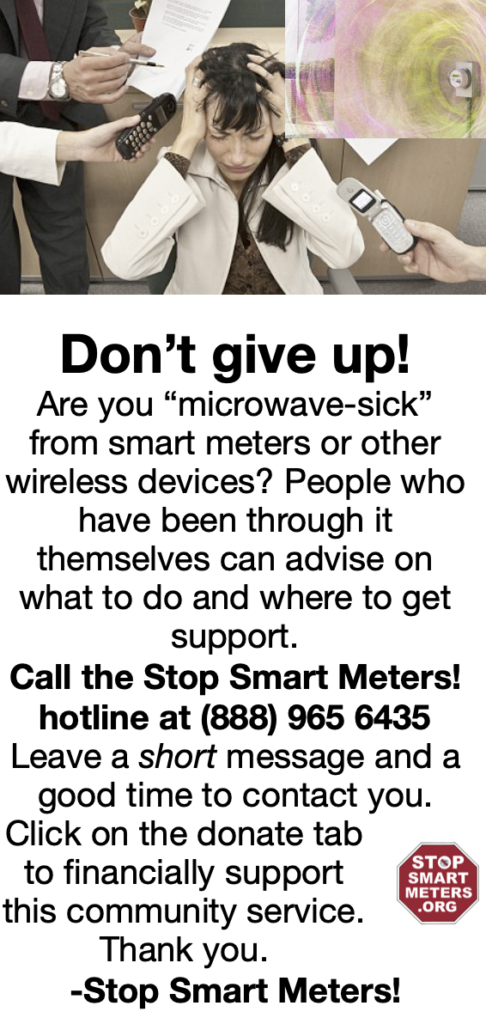
The dream is gone…
By Deborah Kopald, Guest Columnist
Read parts I and II of Deborah Kopald’s Science Denial series here on StopSmartMeters.Org
As for smart meters and other wireless devices, the U.S. has not pre-market safety tested any of them and has not conducted any studies on Wi-Fi, cell towers, or the “smart” grid, while 80 percent of international studies show negative health effects to those who live up to a quarter-mile from cell towers.
Before cell towers were rolled out, the scientific literature showed sleep, cardiovascular, neurological and metabolic problems for people who lived near other microwave-emitting towers like tv, broadcast and air traffic control towers, radar installations and even radiofrequency-emitting radio towers. In part because the cell network relies on what are effectively two-way radio handheld devices to communicate with the towers, more microwave transmitters at closer intervals are required to run wireless networks than these older radiation-emitting transmission systems needed. Even more towers are required now that the government has permitted telecom companies to enable people to transmit not only phone calls wirelessly, but endless amounts of data and video, which should be transmitted by wire or cable instead.
Back in 1993, the California Public Utilities Commission had recommended siting towers away from schools and hospitals (by extension, that guidance should have included residences, since children and vulnerable populations also reside there). Independent scientists suggested that towers should be set at least a quarter-mile away– the approximate distance for the power density to level off; by 2009, the EU stipulated that towers should be kept away from schools, hospitals and old-age homes.
The first question people should have asked themselves when Wi-Fi was rolled out is how does this radiation compare to a tower? A layperson with a rudimentary grasp of physics but an inquisitive mind would have understood that proximity to the transmitter is the larger factor in radiation exposure than total power output. Per the math (verifiable by measurement), ubiquitously Wi-Fi-ed institutions expose many of their inhabitants to more radiation than they would get picnicking close to a cell tower. Even with the relatively lower-powered Wi-Fi in homes, people’s cumulative exposure from regular use of Wi-Fi exceeds the exposure most of them are getting from most cell towers.
So why would anyone have permitted the ubiquitous rollout of a technology (Wi-Fi) that would expose many people to more radiation than they would get from even a cell tower that was poorly sited (not at a distance per early precautionary warnings)? While it is understandable that the public believes that anything that is legally sold has been properly vetted for safety, blame should squarely be laid at the feet of the managers of institutions–schools and private and public sector offices– for deferring to their IT departments and not inquiring into the sense of exposing building occupants to microwave radiation all day.
In any event, many didn’t notice the transmitters going on their rooftops and on the walls and ceilings of their offices, schools and public buildings or grasp the implications of bringing transmitters in closer to human environments. While cell phones obviously present the most intense exposures, people are not exposed to them continually; indeed a 2009 Swiss study showed that on average, people moving in and out of urban areas got more cumulative exposure from transmitters than from their cell phones. Nevertheless, cell phone use, as previously discussed, is linked with a host of problems from cancers, to concentration problems and headaches. It isn’t hard to connect the dots and realize that extra cumulative radiation — indeed extra radiation that exceeds what people are getting from their daily use of a cell phone — presents a public health problem.

A shrub surrounding a smart meter in Ontario, Canada shows biological effects close to the meter
Smart meters, wireless meters that are like mini-cell towers placed on the side of people’s homes (in lieu of meter readers), are perhaps the most noticeable devices to be rolled out exposing the public to an involuntary continual stream of microwave radiofrequency radiation. The perceived involuntary nature of the exposure, sanctioned by the government (and indeed a number of “environmental” groups like EDF (one of their trustees is married to a venture capitalist who is profiting handsomely from forced transmitter rollout– as is Al Gore, an “Inconvenient Truth” if ever there were one) and the Sierra Club, which should know better), adds to the grief that people get from having a smart meter forced onto the side of their homes.
The relative health impact of any device is going to depend upon how much and how often you use it/ are exposed to it and how close you are to it. People are focused on the smart meter because it creates a more obviously involuntary exposure, and depending on its relative location to the areas you frequent (bedroom, office), it can make you very sick, very quickly. However, many who are concerned about smart meters are using Wi-Fi, and in many cases, their cumulative exposure from regular use of Wi-Fi will exceed that of the radiation from the smart meter. In the most extreme situations (depending on its location), the smart meter could expose the house dweller to 100x as much radiation as their Wi-Fi router (although, conversely their Wi-Fi router can expose them to more intense radiation than their smart meter depending upon their relative locations). In addition, the smart meter emits high-intensity spikes that are particularly disruptive to human physiology. Together these exposures are cumulative. Neither Wi-Fi nor a smart meter should be in or on your home if you want to protect yourself from excessive radiation exposure and/or if you buy the aforementioned concept that you shouldn’t be dwelling near a cell tower. Either Wi-Fi or smart meter exposure will expose people on average to more cumulative radiation than their cell phone use will.

Deborah Kopald’s warning notices for buildings inform the public whether a Class 2B carcinogen is in use on the premises
Again, if the smart meter is on the other side of your headboard, the smart meter could expose you to even more intense radiation than you would get from speaking on a cell phone; so the exposure could be worse than if you had a cell phone on by your head all night. Certainly, if France and India are telling their citizens not to use a cell phone more than 6 minutes per day, and only a half hour a day is linked with significant brain tumor increases, nobody should be forced to sleep with a smart meter on the other side of the wall. Per my last article, our government has no standards for continual exposure — (the German government encourages people to limit their cumulative exposure and not install wireless, microwave-emitting technologies in their homes.) The answer to the question, “how far away is safe enough?” is as follows: there is no safe level of exposure, and peoples’ individual thresholds for permanent harm will vary.
Certainly, it is better if the smart meter is farther away from you, but metal inside the home can create hotspots that expose people to even more radiation than the lax FCC limits, underscoring the point that there are no safe limits. In terms of the radiofrequency interference problem, people with pacemakers or other medical implants are told by utilities (only after being directly asked) to avoid the wall in the house where the smart meter is located. What is indisputable is that smart meters (and by extension the governments that are allowing them to be mandated) create levels of radiation in some people’s houses that are higher than ones already linked to statistically significant levels of disease from cell phones or cell towers.
The Precautionary Principle has been invoked by governments that have called for restricted use of wireless devices and infrastructure and is the rationale for moratoriums on smart meters. (Opt-outs don’t do the Precautionary Principle justice as people still get passive radiation from their neighbors’ smart meters, and apartment building dwellers can be exposed to banks of meters which multiply the total amount of radiation). In any event, we are way beyond precaution at this juncture. This brings me back to Felicity Barringer’s New York Times columns. First, Barringer pointed out that opposition was growing to smart meters. Two days later, she dismissed opponents of smart meters and cell phones as anti-science hypochondriacs.
I emailed Elisa Boxer-Cook, a smart meter opponent in Maine referenced in the original article and Emmy-award winning journalist herself (she was formerly the main anchor of the ABC affiliate in Portland). Her reaction: “I am surprised and disappointed that The New York Times allowed something so clearly biased to be published, without vetting it for fairness and objectivity.” Felicity [Barringer] interviewed me for this story … and it was extremely clear to me … that she had her mind made up … Her arguments here seem to be coming from the industry playbook: paint the opposition as anti-technology.” Maine has since offered the option to opt out of smart meters.
Barringer’s analysis of the smart meter opponents’ “cultural resistance” to “the hierarchist status quo” is utterly beside the point. Besides the hotspots, the federal Interagency Working Group on Radiofrequency Radiation states that the safety limits on pulsed RFR (emitted by smart meters, Wi-Fi, phones and other wireless devices) are not protective of human health, suggesting that the cumulative effect of all the other proliferating sources of RFR is also a problem. The National Academy of Sciences wrote a report in 2008 suggesting that dangerous hotspots could be created by all this radiation around metal – this includes not only furniture in our homes, but metal on our bodies including brassiere underwires, piercings, braces, jewelry, glasses, hair fasteners, belt buckles, shoes and medical implant devices. Norbert Hankin, a then-EPA official, stated over a decade ago that no long-term standards for exposure to radiofrequency radiation even exist. In the absence of standards for long-term cumulative exposure, why is the government subsidizing the rollout of a wireless smart grid? Indeed, why did the FCC announce that landlines would be phased out in certain areas, especially when Congress already held two sets of hearings questioning the safety of cell phones?
Besides the aforementioned technologies and cordless phones, Bluetooth and baby monitors (which are also adding to peoples’ lifetime cumulative exposure to microwave radiation), the FCC has been promoting Distributed Antenna Systems (DAS) to replace wired landlines and wired internet via DSL or cable modem. DAS are the next generation cell towers, and even though they are lower powered than most towers, their proximity to people’s homes means that they are exposing people to more radiation than cell towers. Government promotion of DAS is preventing the marketplace from being incentivized to use and develop safe, non 2b-carcinogen-emitting technologies that could be transmitting utility information by wire.
Besides the DAS fiasco, our other “smart” devices are turning into high-powered hotspots, further collapsing the distinction between a phone and a transmitter. Someone sitting next to you in an auditorium could be exposing you to levels higher than if the auditorium had rented their seat to a wireless company and installed a cell tower there. Children’s “educational tablets” can expose them to comparable levels. Hidden transmitters are being put in city parks and bus stops. (While new sources of radiofrequency radiation are rolled out adding to your cumulative exposure, the mayor of NYC has promoted 2b-carcinogen-emitting transmitters in parks while vigorously fighting public exposure to large portions of sugary soft drinks and smoking outdoors at the beach.) The smart meter is the transmitting device that evokes the most public outrage — and understandably so, since the government is effectively forcing them on private property, and the fact that they are exposing some people continually to more radiation than many people are getting from these other sources individually, if not cumulatively. If Barringer can’t get the smart meter story right, don’t hold your breath for The New York Times (or the rest of the mainstream media for that matter) to untangle the rest of the story of the Rise of the (microwave radiation-emitting) Machines.
Many scientists believe that exposure to radiation from wireless devices and transmitters is trumping smoking and second-hand smoking as a current public health crisis; some have publicly stated that this problem is more serious to human health than global warming. An analysis of the relative health impacts of these problems over time over the whole population is complicated and goes beyond the scope of this piece. It is viscerally apparent to those who have either gotten head cancers from their cell phones, or have developed electro-hypersensitivity — a number that an advisor to the UK Health Protection Agency estimates to be about 10% of the population to date –from exposure to Wi-Fi, smart phones, smart meters, another source or from some combination thereof — that wireless devices and transmitters are a clear and present danger.
Ironically, these technologies are being falsely touted as solving the global warming problem. ((Like smart meters, which do not reduce greenhouse gas (GHG) useage, smartphones are called “green” when in fact it was reported (by The New York Times!) that the data server farms used to house the data and make it available for on-demand wireless transmission creates more GHG than the pulp and paper industry it is supposed to be supplanting.))
For those still in disbelief that this oft-quoted newspaper could have gotten it so wrong, let me point out what happened the last time this country publicly recognized a health crisis caused by electromagnetic radiation. From the 1970’s until 1987, Suffolk County, NY passed historic legislation protecting its county workers from video display terminals (VDTs); these data entry computer terminals were being used by clerks, airline reservationists and newspaper workers and were causing miscarriages, stillbirths and birth defects to pregnant workers. Other workers got eyestrain from VDT radiation. After Suffolk’s Law and a report by Kaiser Permanente, the VDTs were yanked off the market and redesigned to be relatively safe…but not before The New York Times wrote an editorial pooh-poohing the science, while simultaneously fending off a lawsuit by its own workers, who complained of ill-health from VDTs.
Unfortunately while VDTs were wired devices and could be redesigned to cancel out currents and magnetic fields, the current spate of problems cannot be fixed this way; wireless radiation radiates out into space and the existing set of devices interact with an array of fixed transmitters. The only way to protect the public’s health is to reduce exposure. The government needs to be told (repeatedly, apparently) to stop allowing its regulated utilities to mandate microwave radiation-emitting transmitters on people’s homes. Neither the government nor the Felicity Barringers and The New York Times‘ of the world will act in the public interest unless enough of us stand up to terminate the belief that our health is less important than the machines that are driving the corporate bottom line.
Deborah Kopald (BA, Harvard; MBA, MIT Sloan School of Management) is an environmental health and public policy advocate who has authored numerous articles and a forthcoming book about electromagnetic pollution. She developed and oversaw the promotion of successful legislative initiatives at the local, and county and state levels in New York State, has addressed 35 offices of Congress, has appeared as an expert guest on television and radio programs, and has been an invited speaker at SUNY campuses, Rotary Clubs, parents groups, two county legislatures, the NY State Senate, the Association of Towns and various municipal governments. She received an award from Orange Environment in October, 2011 for her public education efforts and advocacy of transmitter-free zones.

Copyright 2011, Deborah Kopald, all rights reserved











